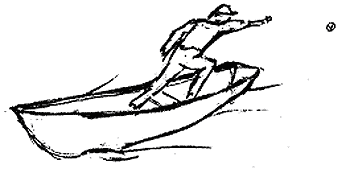| For a boat to move through the water there has to be
a force applied. One way to produce a force is to accelerate
a mass.
You could move your boat by throwing baseballs over the
stern. A 5 ounce ball thrown by a good pitcher will give
you over 1 pound of thrust for the time from wind-up to
follow-through. With that kind of force a small boat might
gain very slowly against a 5 mph head wind. It works, but
balls are expensive and it gets hard on the arm after a
while.

Take a paddle or an oar and push a chunk of
water faster than the water around it and you have the same
effect. The acceleration is less and the mass is greater
than the baseball scheme, but the force averages to about
3 to 10 pounds on a lazy day.
A propeller is in effect a bunch of paddles
doing J strokes. Push water back through the water around
it and your boat moves forward. The area and angle of the
blades determines the size of the chunk of water, the mass.
The acceleration part is a bit more complicated and involves
pitch, the spinning speed of the shaft, and the speed the
boat is doing. Put them all together and you get thrust.

In the old days propellers were called screws.
The idea was that they screw into the water, but it was
noted that the actual headway was always less than what
would happen if it really was cutting through water. Prop
people refer to this difference as slip, leading some people
to think it should be avoided, but slip is what accelerates
the mass. If you have a small propeller and spin it fast
you can generate the same thrust as a larger propeller moving
more slowly, you have more slip. You’d use more power
with a smaller prop because friction increases four times
as you double the spin, while the force just doubles. There
are limits, but generally the best efficiency comes from
a big prop turning slowly with just a little slip. You’ll
never see these limits approached in a motor boat but in
something like human powered submarines you might see a
24” prop powered by a half horsepower set of legs.
That is where the quest for efficiency turns into an obsession.
Hydro jets go the opposite way and connect 300 horsepower
to a 6” impellor.
As your boat picks up speed, the prop has
to turn faster just to keep up with the boat. When you are
at cruising speed the prop blades are just kissing the water
as it passes under the boat. The real work happens when
a planing hull is trying to get out of the hole and climb
up the bow wave. The engine is laboring, producing less
than full power. The prop is struggling to throw as much
water as it can as fast as it can, a good part it sideways
where it does no good. A bit of air gets sucked down from
the surface and a bit of vapour gets sucked out of the water,
and this ventilation and cavitation just irritates the prop.
But if all goes well, the nose comes down, the boat sits
up on top of the bow wave and everybody is happy. If not,
you have to turn back, leave Aunt Bertha on shore, and try
again. Having to get the boat out of the hole and still
cruise economically is a big part of what makes prop design
and selection such a voodoo exercise.

|

